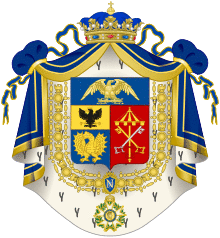| Camillo Borghese | |||||
|---|---|---|---|---|---|
| Prince of Sulmona Prince Of the French Empire Duke of Guastalla Governor of Piedmont | |||||
 | |||||
| Prince of Sulmona | |||||
| Reign | 1800-1832 | ||||
| Predecessor | Marcantonio Borghese | ||||
| Successor | Francesco Borghese | ||||
| Duke of Guastalla | |||||
| Reign | March 1806- May 1806 | ||||
| Predecessor | Ferdinand | ||||
| Successor | Duchy annexed by Parma | ||||
| Governor of Piedmont | |||||
| Reign | 1800-1814 | ||||
| Predecessor | office established | ||||
| Successor | office dissolved | ||||
| Personal Details | |||||
| Born | 19 July 1775 | ||||
| Died | 9 May 1832 In Florence | ||||
| Spouse | Pauline Bonaparte | ||||
| |||||
| House | House of Borghese | ||||
| Occupation | Division General in the French Imperial Army (Grande Armée) | ||||
Don Camillo Filippo Ludovico Borghese, Prince of Sulmona and of Rossano, Duke and Prince of Guastalla (19 July 1775 – 9 May 1832) was a member of the Borghese family, best known for being a brother-in-law of Napoleon.
He married Napoleon’s little sister, Pauline Bonaparte in 1803, which led to him getting multiple titles, gifted by Napoleon to him.
But after Napolen’s defeat he left France leaving his wife alone.
He was stripped of his titles given to him by Napoleon and left with his titles which he earned by birth right.
While in Florence he died at the age of 56, the cause of death is unknown.
Apart from his Royal life, Camillo was also part of the French Imperial Army, being a Divisional general and leading the 27th and 28th Division in the French army.
Biography
Camillo Borghese was born in Rome, the son of the pro-Napoleon Marcantonio Borghese, 5th Prince of Sulmona, and brother of Francesco (1776–1839), Prince Aldobrandini. He entered France's service in 1796. He became the second husband of Napoleon's sister Pauline Bonaparte in 1803 (after the death of her first husband, Charles Leclerc).
Initially passionate (he commissioned a nude statue of her from Canova), the marriage later foundered due to her taking a series of lovers and showing eccentricities such as being carried to her baths by her African slaves and using her ladies-in-waiting for footstools. They led separate lives but did not divorce, and Pauline convinced her brother to give Camillo the governorship of Piedmont in 1808 (with the words "Camillo is an imbecile, no one knows that better than I do. But what does that matter, when we're talking about governing a territory?") and guardianship of Napoleon's prisoner Pope Pius VII.
Napoleon also forced him to sell 344 pieces from the family art collection to the French state, which Camillo made up with new pieces from excavations on his estates. Camillo also took an interest in the family villa at Porta Pinciana, rearranging the display of the collection within it and giving it a new monumental entrance at Piazza del Popolo.
After 10 years there with a long-term mistress, he was reluctantly convinced by the pope into receiving Pauline back, only 3 months before she died of cancer. He then continued in secret and futile Bonapartist plots until his own death, which occurred at Florence in 1832. He was succeeded in his non-Napoleonic titles by his brother Francesco.
Influence over history
While a barely remembered figure of the Napoleonic Wars, he was an important figure, with direct ties to the Emperor of the French, being the Duke of Guastalla, a Prince of the French Empire, and also being the Governor of Piedmont from 1808 until the fall of Napoleon.
He is the reason why most remember the House of Borghese, as he is the most remembered member of this house, which is slowly being forgotten.
Sources
- Majanlahti, Anthony (2005). The Families Who Made Rome. London: Chatto & Windus. pp. 205 and 180–181. ISBN 0-7011-7687-3.

